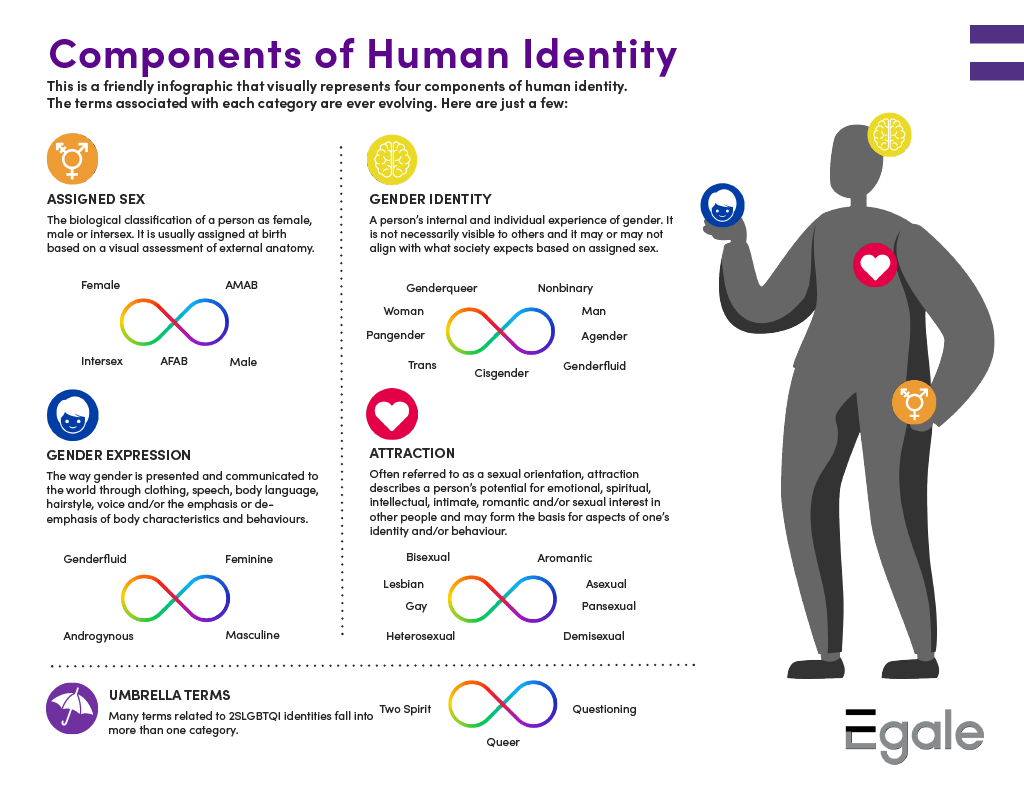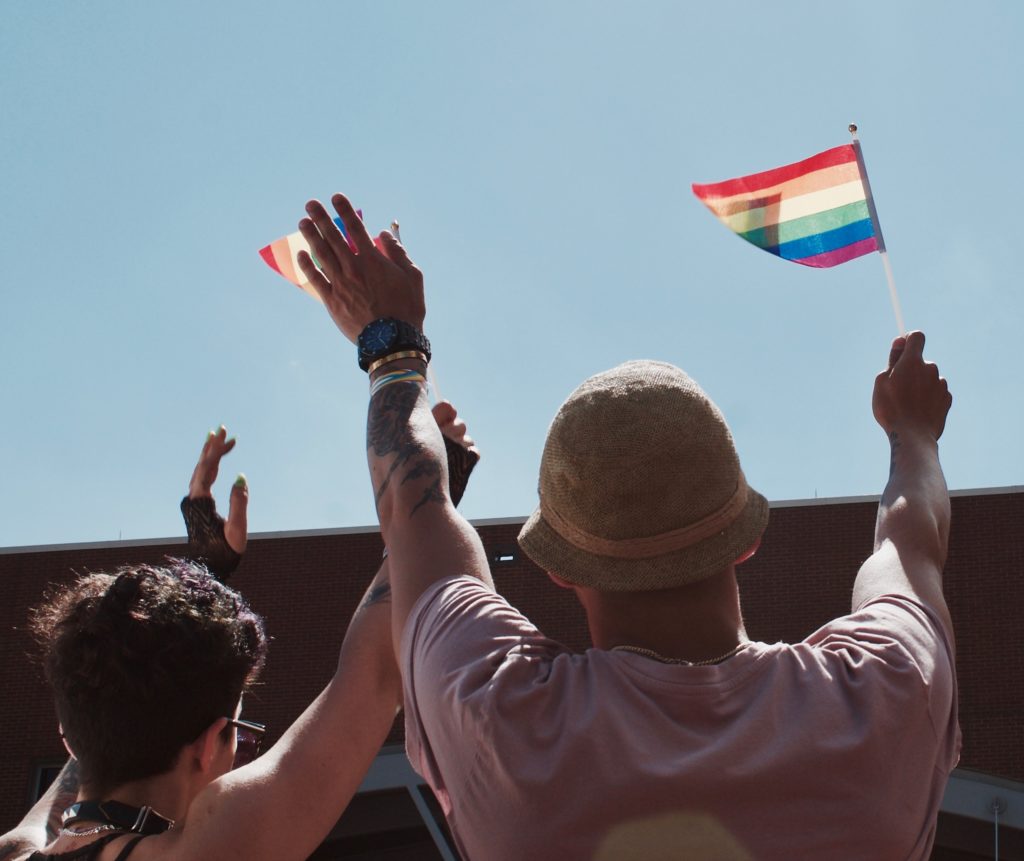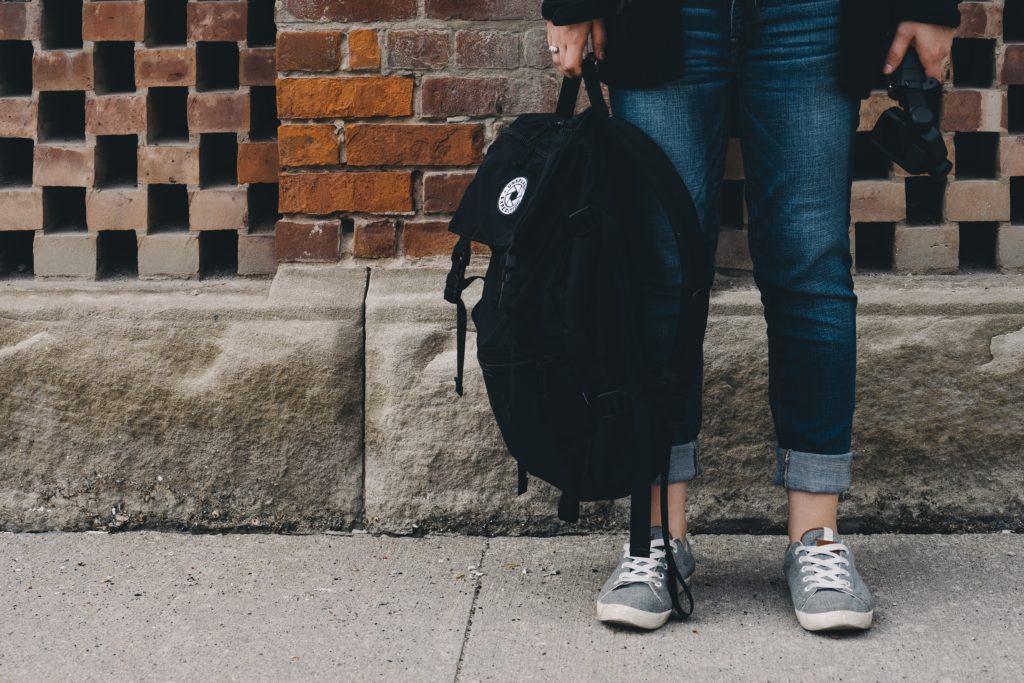Related resources:
- Transgender people and suicide fact sheet
- Transgender people and suicide toolkit
- Sexual minorities and suicide fact sheet
 Because sexual orientation is not usually included in a cause of death report or on a death certificate, there is little data connecting sexual minorities and suicide. However, we know from survey data, as well as several studies, that lesbian, gay and bisexual youth are at a higher risk for suicide than their straight peers (Egale Canada, 2011; Haas, 2011; Kitts, 2005). This is because they face stressors that are unique, including stress from being part of a minority group. Studies and surveys have shown many LGB people have thought about or attempted suicide, and previous behaviours such as these are the most reliable indicators of future suicide risk (Suicide Prevention Resource Center [SPRC] & Rodgers, 2011).
Because sexual orientation is not usually included in a cause of death report or on a death certificate, there is little data connecting sexual minorities and suicide. However, we know from survey data, as well as several studies, that lesbian, gay and bisexual youth are at a higher risk for suicide than their straight peers (Egale Canada, 2011; Haas, 2011; Kitts, 2005). This is because they face stressors that are unique, including stress from being part of a minority group. Studies and surveys have shown many LGB people have thought about or attempted suicide, and previous behaviours such as these are the most reliable indicators of future suicide risk (Suicide Prevention Resource Center [SPRC] & Rodgers, 2011).
Definitions
Sexual orientation includes sexual behaviour, romantic attraction and self-identification.
Sexual minorities generally refer to those who have a different sexual orientation than the majority population.
LGBTQ2S+ is an acronym for lesbian, gay, bisexual, transgender, queer or questioning, and Two-Spirit. We refer only to LGB people in this toolkit because the research we cite refers specifically to these groups. We have a separate transgender and suicide-specific toolkit, and acknowledge that more research into queer, questioning and Two-Spirit people and suicide is needed.

(Egale Canada Human Rights Trust, 2022)
Statistics
- Approximately 3% of the Canadian adult population identified as lesbian, gay, or bisexual (Statistics Canada, 2017)
- Lesbian, gay and bisexual youth are more at risk for suicide than their straight peers. They are:
- 5 times more likely to consider suicide
- 7 times more likely to attempt suicide
(Suicide Prevention Resource Centre [SPRC], 2008)
Are LGB people more at-risk of suicide?
LGB people are more at risk for suicide than heterosexual people. Studies and surveys have shown many have thought about and attempted suicide, and previous suicidal behaviours such as these are the most reliable indicators of future suicide risk (SPRC, 2008).
Existing research also finds that LGB populations are predisposed to depression, anxiety and substance abuse (Haas et al., 2011). If left untreated, these mental health disorders can also be indicators for suicide risk.
Risk Factors
Certain factors can place people at a higher risk for suicide than others. Here are some risk factors specific to the LGB population:
- age: LGB youth are at a higher risk for suicide than LGB adults
- discrimination manifesting as bullying, physical violence, rejection (leading to isolation); this is especially prevalent among LGB youth who are at higher risk for suicide than LGB adults
- lack of support from parents and other family members
- mental illness (including depression and anxiety)
- predisposition to depression, anxiety and substance abuse (Haas et al., 2011)
- LGB individuals who consider suicide face dual stigma of being different in sexual orientation and the stigma of suicide in general
- isolation from conventional society
- body image anxiety
- institutional prejudice manifesting as laws and policies which create inequalities and/or fail to provide protection from discrimination
- access to lethal means (e.g. firearms, prescription drugs)
(Haas et al., 2011; SPRC, 2008; Pachankis, 2015)
Warning signs
Any significant change in behaviour or mood is a warning sign that someone may be thinking about suicide, for example:
- losing interest in a previously enjoyed hobby or activity
- disconnecting from friends or family
- change in sleeping or eating patterns
- drinking alcohol or taking drugs to excess
Statements of hopelessness or talk of being a burden can also be warning signs:
- “I don’t fit in at all with my classmates… it feels like I’m the only gay person I know”
- “I wish my family members would accept me for who I am… I feel like I have no one in my family to talk to”
If you notice anyone exhibiting the following signs get that person help immediately – call 9-1-1 or your local distress centre.
- threatening to hurt or kill themselves
- talking or writing about dying or suicide
- seeking out ways to kill themselves
(American Association of Suicidology, 2017)
If someone you know is exhibiting warning signs, have an open, non-judgmental conversation with them. You can start the conversation by mentioning your concerns, “I’ve noticed you’re not coming to class as often as you used to, how’re you doing?” or, “You say your mom hasn’t been very supportive since you’ve come out to her. Are you okay?” Listen to them, be there for them. You don’t have to offer solutions. If the person responds with statements of hopelessness or being a burden, ask them about those feelings. Then, ask them directly, “Are you thinking about killing yourself?”
LGB youth are at a higher risk of suicide
LGB youth have a higher risk of suicidal thoughts and actions; suicide attempts in the LGB population decrease significantly after adolescence (Paglia-Boak et al., 2010). This is probably due to the struggle, common to many teens, of finding one’s own identity and place in the world. Children and teens who are perceived as different in some way may be bullied and harassed, making their school lives a more negative experience. Adults, generally, have come to terms with who they are and have friends and other social supports who support and positively impact them.

Additional risk factors for LGB youth:
- homelessness
- living in foster care
- involved in the juvenile justice system (Saewyc et al., 2014; SPRC, 2008)
Homeless LGB(TQ) youth
LGBTQ youth are greatly overrepresented in the homeless youth population in North America.
Approximately 30% of homeless youth identify as LGBTQ compared to 10% of the general population. The shelter system (which houses homeless youth intermittently) should be accountable for fostering safe spaces for all youth, irrespective of sexual or gender identity and staff should be trained on “issues relating to LGBTQ youth culture, terminology, needs, homophobia and transphobia” (Abramovich, 2012, p.47).
Protective Factors
Certain factors can help people build resiliency and protect them from thinking about suicide. Here are some protective factors specific to the LGB population:
- membership in Gay-Straight Alliance (GSA) if school age
- accessible and non-discriminatory mental health care and healthcare
- community and school supports
- strong relationships with family and friends
- self-awareness and acceptance
- independence of thought (the ability to see past the “traditional” views of society)
(Saewyc et al., 2014; Dorais, 2004; Haas et al., 2011)

What can LGB people do to stay mentally healthy?
- Hang out with people who are loving and supportive.
Prioritize relationships with supportive family members and friends and consider becoming involved in LGB community organizations or Gay-Straight Alliances (GSAs). - Maintain mental health and ask for help when it is needed!
Try to limit alcohol and drug use and if support is needed, reach out for help. When struggling to cope with life, tell a trusted loved one or call your local crisis line.

What can communities do to help reduce suicide among LGB people?
Healthcare Practitioners
Those on the front lines of healthcare need to be more involved in identifying those who might be considering suicide in the LGB community.
Physicians should be aware of LGB risk factors. (Abramovich, 2012; Saewyc et al., 2014; Kitts, 2005)
LGB bullying prevention in schools

Bullying of LGB youth is prevalent in schools, and is directly related to their sexual orientation:
- 1 in 4 LGB students is physically harassed
- 6 in 10 LGB students are verbally abused
- when incidents of harassment are reported to school staff, often they do not intervene to stop the harassment
(Egale Canada, 2011)
Schools need to play an active role in ending LGB harassment and discrimination, and in the past few years, many Canadian schools have integrated policies and programs to ensure LGBTQ students feel safe.
The school experience of LGBTQ students is improved when schools/school divisions develop and encourage:
- safe-school policies and procedures specifically addressing homophobia
These policies create an environment where LGBTQ students feel safer, more accepted, and more attached to their schools. In schools where these policies are in place, harassment of LGBTQ students is reduced, and in the instances of harassment, LGBTQ students are more likely to report the harassment to school staff and staff is more likely to intervene.
- policies supported from the division-level down to the individual school
Policies supported from all levels of the school system are most effective, because staff and students realize the policies have institutional endorsement and are actively enforced.
- support for the efforts of students to start Gay-Straight Alliance clubs (GSAs).
GSAs help encourage solidarity amongst a larger group of the student population; LGB students know they are supported by their straight peers (Saewyc et al., 2014; Egale Canada, 2011).
As an example, the Alberta government passed legislation-Bill 24—which strengthens rules around gay-straight alliances in schools. The law makes it more difficult for schools to deny students the right to form GSAs (Bennett, 2017).
Resources
Camp Fyrefly is a Canadian leadership retreat for sexual and gender minority youth.
Egale Canada is Canada’s LGBTQ human rights organization: advancing equality, diversity, education, and justice.
The Trevor Project is an organization providing crisis intervention and suicide prevention services to lesbian, gay, bisexual, transgender, and questioning youth.
It Gets Better is a project created by Dan Savage to inspire hope for young people who are lesbian, gay bisexual or transgender facing harassment.
The Youth Project is a premier resource for LGBTQ youth and the general public to learn about sexuality and gender issues.
“Don’t you see… I’m fighting for… my whole life and the lives of other gay people. I’m fighting for what so many people don’t understand. I’m trying to speed up the process of equality because I am sick of being treated like someone absent of feeling and emotion”
(Grace and Wells, 2005, p.246).
References
Abramovich, I. (2012). No safe place to go: LGBTQ youth homelessness in Canada: Reviewing the literature. Canadian Journal of Family and Youth, 4(1), 29-51. Retrieved from http://ejournals.library.ualberta.ca/index.php/cjfy/article/download/16579/13220
The American Association Suicidology. (2018). Know the warning signs of suicide. Retrieved from http://www.suicidology.org/resources/warning-signs
Bennett, D. (2017, November 15). Alberta passes contentious bill strengthening gay-straight alliance rules. Globe and Mail. Retrieved from https://www.theglobeandmail.com/news/national/alberta-passes-contentious-bill-strengthening-gay-straight-alliance-rules/article36986351/
Dorais, M. (2004). Dead boys can’t dance. Montreal-Kingston: McGill-Queen’s University Press.
Egale Canada. (2011). Every Class in Every School: The first national climate survey on homophobia, biphobia, and transphobia in Canadian schools (Final Report – May 2011). Retrieved from http://archive.egale.ca/index.asp?lang=E&menu=4&item=1489
Egale Canada Human Rights Trust (2022, January 7). Genderbread Person: Components of Human Identity. https://egale.ca/awareness/the-genderbread-person/
Elementary School Teachers of Ontario. (2003). Challenging Homophobia and Heterosexism. Retrieved from http://www.tdsb.on.ca/_site/viewitem.asp?siteid=15&menuid=5401&pageid=4717
Haas, A., Eliason, M., Mays, V., Mathy, R., Cochran, S., D’Augelli, A., Silverman, M., Fisher, P., Hughes, T., Rosario, M., Russell, S., Malley, E., Reed, J., Litts, D.A., Haller, E., Sell, R.L., Remafed, G., Bradford, J., Beautrais, A.L., Brown, G.K., Diamond, G.M., Friedman, M.S., Farofalo, R., Turner, M.S., Hollibaugh, A. & Clayton, P. (2011). Suicide and suicide risk in lesbian, gay, bisexual and transgender populations: Review and recommendations. Journal of Homosexuality, 58(1),10-51.DOI: 10.1080/00918369.2011.534038
Kitts, R. (2005). Gay adolescents and suicide: Understanding the association. Adolescence, 40 (159),621-628.
Pachankis, J. (2015). A transdiagnostic minority stress treatment approach for gay and bisexual men’s syndemic health conditions. Archives of Sexual Behavior, 44(7), 1843-1860.
Paglia-Boak, A., Mann, R., Adlaf, V., Beitchman, J., Wolfe, D. & Rehm, J. (2010). Suicide and suicide risk in lesbian, gay, bi-sexual and transgender populations: Review and recommendations. Journal of Homosexuality, 58(1), 10-51.
Saewyc, E., Konishi, C., Rose, H., & Homma, Y.( 2014). School-based strategies to reduce suicidal ideation, suicide attempts and discrimination among sexual minority and heterosexual adolescents in western Canada. International Journal of Child and Youth Family Studies, 5(1), 89-112.
Statistics Canada. (2017). Same sex couples and sexual orientation. Retrieved from https://www.statcan.gc.ca/eng/dai/smr08/2015/smr08_203_2015#a3
Suicide Prevention Resource Center. (2008). Suicide risk and prevention in gay, lesbian, bisexual and transgender youth. Newton, MA: Education Development Center, Inc. Retrieved from http://www.sprc.org/sites/default/files/migrate/library/SPRC_LGBT_Youth.pdf